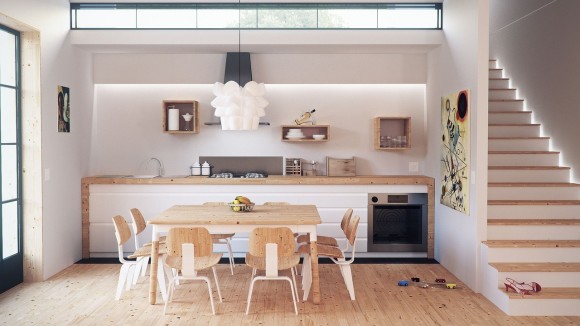Exploration Edit: Japanese Interior Design

Japanese construction and interior design is imitated across the globe, and it’s not difficult to see why. Along with their love of minimalism, harmony and unique design features, the Japanese are known for their environmentally conscious techniques. As such, the spaces they create are fresh, peaceful and clutter free, enhanced by artisanal idiosyncrasies and a passion for nature.
We have great respect for the sustainability demonstrated in Japanese architecture and interiors, and thoroughly enjoy seeing these techniques mimicked by other builders and designers that want to be more ‘green’. These include compact buildings and spaces with a smaller ecological footprint, natural and sustainable materials from local suppliers, and cost-effective construction and decorating methods.
We’re going to explore the typical Japanese home in a little more detail, describing the efficient features and unique qualities, and explaining how you too can achieve a Zen space…
__________________________________________________________________
An overview of Japanese interior design
A Japanese home feels fresh and pure, thanks to the natural sunlight that pours in and the flourishes of lush green and vibrant pink that punctuate the otherwise neutral space. A love of nature is ingrained in Japanese culture, and this respect and admiration can be seen in traditional interior design. Nature is welcomed indoors through expansive windows, and plants including bonsai trees, bamboo and orchids adorn the floor and any available surfaces.
Japanese interiors continue their harmony with nature through the use of wooden elements. While wood plays a major role in a range of interior styles, it is exemplified to its full extent in Japanese design. By avoiding paint and heavy finishes, the natural beauty of soft, warm tones and delicate woodgrains is highlighted. In a similar manner, the simplicity of Japanese furniture and flooring design makes the material the star of the show. Maple, pine, bamboo and wicker are some of the most popular wood materials in Japanese design, utilised in all aspects of the home.
A well-known design feature of Japanese homes is the screen – or, technically speaking, a Shoji. These screens consist of translucent paper pulled tight between wooden frames, used to divide up rooms and offer privacy. Shojis slide neatly back and forth, and therefore use a lot less space than swinging doors and other bulky dividers. They help to maintain the bright, airy feel of Japanese interior design, filtering light gently rather than blocking it completely.
Another popular feature of traditional Japanese homes is the furniture. Sparse and simple, Japanese beds and tables are also typically more squat than Western versions, owed to a centuries old floor culture. Many families still feast while sat on cushions around their low table, and sleep on futons upon tatami, the woven mats that are synonymous with Japanese interiors.
Japanese design is typically minimalist, and you’re unlikely to find clutter, clashing colours and busy prints within these spaces. Instead, the style calls for simple pieces and neutral tones, with interest being added through fabric textures and stylish, modern lighting solutions.
__________________________________________________________________
How to achieve the Japanese look

Japanese interior design techniques aren’t just limited to their homeland. The methods are practiced across the globe, utilised time and time again by seasoned interior designers and novice decorators alike. The style is a go-to source of inspiration for homeowners dreaming of a spacious and serene home, while its unique furniture and furnishings provide striking alternatives to traditional pieces.
The elements of Japanese interiors lend themselves to the modern, minimalist space. They help to create a light and airy atmosphere, where there is plenty of peace and balance. Look for natural materials in pale neutral tones, choosing the bare and basic over glossy finishes and detailed adornments. Keep walls plain, adding interest through carefully selected piece of artwork.
Japanese interior design is renowned for its incorporation of stylish lighting solutions. Think modern lampshades in light, bright tones with a quirky, geometric form. Frosted glass or paper will mirror the translucent quality of other Japanese design features, as well as gently diffusing light for a peaceful ambience. Harsh lighting will certainly damage the soft, natural energy that your space achieves, so be sure to choose gentle glows over strong beacons.
Strong lines and crisp edges offer simplicity, helping to maintain a clean and uncluttered home. This linear approach also brings order, another key feature of Japanese design. Ensure that every item of furniture and every ornament has a place and a space – thoughtless arrangements and hectic areas will quash your home’s serenity. Research the art of Feng Shui to boost your home’s balance and the flow of energy. It’s amazing how some minor rearrangements can make a world of difference to a space!
 Low to the ground furniture is unequivocally Japanese, and you can achieve this look by tracking down low beds, tables and foot stools, as well as adding floor cushions to your space. Keep things modern by opting for bright colours from nature’s palette – lush greens, warm yellows, sea blues and hot pinks work well.
Low to the ground furniture is unequivocally Japanese, and you can achieve this look by tracking down low beds, tables and foot stools, as well as adding floor cushions to your space. Keep things modern by opting for bright colours from nature’s palette – lush greens, warm yellows, sea blues and hot pinks work well.
In terms of flooring, steer clear of carpets and choose vinyl, laminate, tiles or authentic wood if possible. These flooring solutions will amp up the space of your room and keep the look cool and contemporary. Authentic Japanese tatami may not be suitable, but a stylish rug in soft tones will help to channel more eastern vibes.
The Japanese look can also be achieved through your window dressings. Add another layer to your interior design through sheer fabric or bamboo, which will both nod towards Japanese style. If you prefer curtains, choose light cream fabrics over thick, heavy material, and keep things simple in terms of tiebacks and accessories. The clean lines of venetian or wooden blinds will also work well, complementing the rest of your space’s natural, linear features. Light wood blinds have a distinct Japanese feel and will correspond with the other pale neutral pieces in your space. Cedar wood blinds are also an excellent choice, highlighting one of Japan’s favourite timbers, which is also known as sugi.
Are you a fan of Japanese interior design? Do you feel passionately about eco-friendly living? Get in touch with us @InteriorGoods and let us know what you think, and be sure to click the button below to discover our full range of sustainable wooden blinds.

